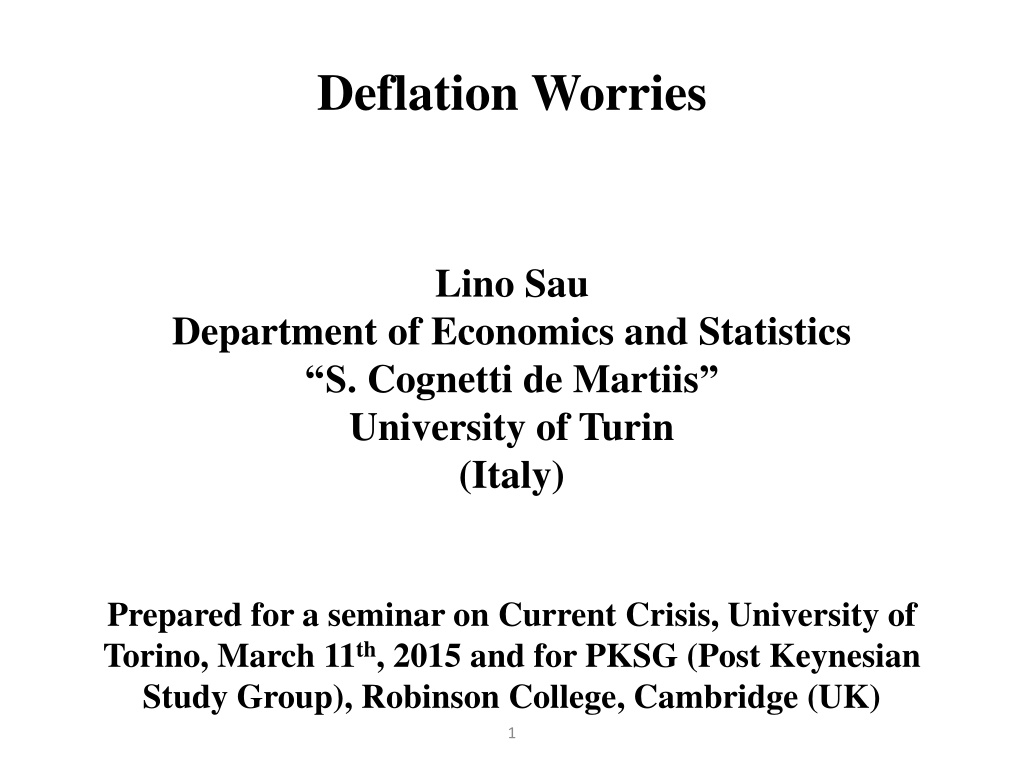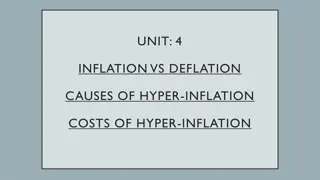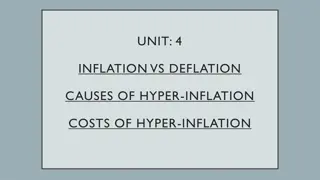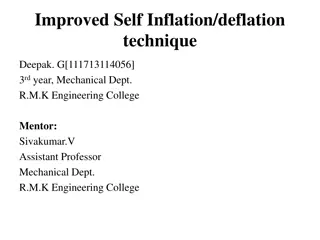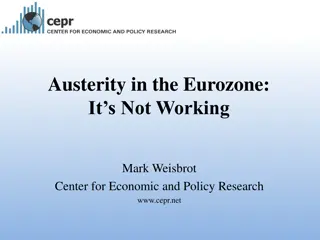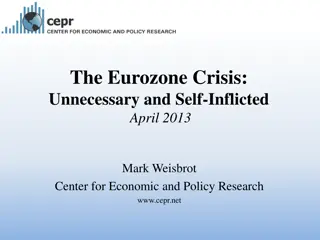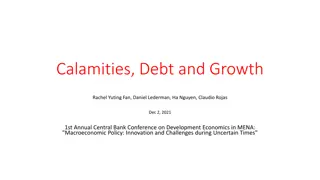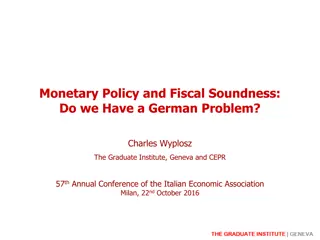Understanding Deflation Worries in the Eurozone and Fisher's Debt Deflation Theory
Recent concerns about deflation in the eurozone have led to discussions about the potential impacts on the economy. This article explores the Eurostat index data showing a significant drop in inflation levels across several European countries. It also delves into Irving Fisher's Debt Deflation theory, which describes the chain of events that can occur when over-indebtedness leads to distress selling, price falls, and economic distress. The historical context of deflation and its potential implications are discussed in relation to the current economic situation.
Download Presentation

Please find below an Image/Link to download the presentation.
The content on the website is provided AS IS for your information and personal use only. It may not be sold, licensed, or shared on other websites without obtaining consent from the author. Download presentation by click this link. If you encounter any issues during the download, it is possible that the publisher has removed the file from their server.
E N D
Presentation Transcript
Deflation Worries Lino Sau Department of Economics and Statistics S. Cognetti de Martiis University of Turin (Italy) Prepared for a seminar on Current Crisis, University of Torino, March 11th, 2015 and for PKSG (Post Keynesian Study Group), Robinson College, Cambridge (UK) 1
There has recently been a marked increase in concern about deflation, particularly in the euro zone. As even both the Financial Times and The Economist recently (2013) put it: the ghost of deflation is in the euro zone! Relatively few people alive today have experienced deflation, but for Europeans that may now be changing. Indeed, prices are falling and inflation remains stubbornly low. 2
Eurostat index shows that inflation dropped to 0.9% for the euro zone as a whole since September 2013. That is way under the European Central Bank (ECB) target which is close to 2%. Over the past months the trend has intensified. France, Italy, Spain, Portugal, Greece, Cyprus, Ireland, Slovakia, Slovenia, Estonia and Latvia have all seen price falls, and already have one foot in deflation. Much the same is happening in Bulgaria, Romania, Hungary and the Czech Republic. Poland is at zero. Denmark is close, and so is Sweden. 4
As we know all too well, the phenomenon of persistent falling prices across the economy blighted the lives of millions of people in the 1930s. In this connection Irving Fisher tried to explain this macroeconomic malady in his well known Debt Deflation theory of Great Depressions (Econometrica, 1933), which may be considered the seminal work for the development of the so- called debt deflation school (Keynes, 1930; Tobin, 1980, Minsky, 1982 et al.) in political economy. 5
Fishers assumed that: at some point of time, a state of over-indebtedness exists, this will tend to lead to liquidation. Then we may deduce the following chain of consequences in nine links: (1) Debt liquidation leads to distress selling and to (2) Contraction of deposit currency, as bank loans are paid off, and to a slowing down of velocity of circulation. This contraction of deposits and of their velocity, precipitated by distress selling, causes (3) A fall in the level of prices, in other words, a swelling of the dollar. Assuming, as above stated, that this fall of prices is not interfered with by reflation or otherwise, there must be. (4) A still greater fall in the net worth of business, precipitating bankruptcies and 6
(5) A fall in profits, which in a "capitalistic," that is, a private-profit society, leads to a fall in aggregate investments (6) A reduction in output, in trade and in employment of labour. These losses, unemployment, lead to: (7) Pessimism and loss of confidence, which in turn lead to (8) Hoarding and slowing down still more the velocity of circulation. The above eight changes cause (9) Complicated disturbances in the rates of interest, in particular, a fall in the nominal rates and a rise in the real rates of interest. bankruptcies, and 7
Over the years the theory of debt deflation considered above has come in for criticism on various fronts. 1st. Deflation process is indeed rare, and even of little theoretical or practical relevance. But! it is worth noting that the persistence effects considered above can also come about without a simultaneous fall in the level of consumption good prices and capital goods; all that is needed, in fact, is for the deflation process to hit the prices of real and/or financial assets a case by no means rare or isolated in the economic history (cf. real-estate busts in recent time (Arestis-Karakitsos, 2003; Sau, 2013). 8
2nd. Mainstream economists observed that a fall in the general level of prices can have reasonably limited effects since it brings about a simple redistribution in wealth from debtors to creditors: But! At this regards Tobin (1980) demonstrated if the marginal propensity to spend on the part of the debtors (consisting mainly of entrepreneurs and households) is, as might reasonably be expected, greater than that of the creditors, the fall in prices may prove far from stabilising. Furthermore if the debtors go bankrupt the creditors find themselves having to bear the heavy losses in part through credit recovery and also due to the state of widespread insolvency. 9
Then on proceeding from static to dynamic analysis, it immediately becomes crucial to consider the role of expectations vis- -vis future prices. It is quite possible that the original price decline will lead to the expectation of further declines. Purchasing decisions will be postponed, aggregate demand will fall off, unemployment increased still more. and the amount of 10
New approaches inside the debt-deflation school have taken into account the increasing complexity and integration in the financial systems during the age of globalization due to the adoption of the neo- liberal paradigm by many emerging and developed countries. - In the US, this paradigm stemmed on late 70 s and was followed and embraced by many European countries during the 80 s and 90 s: laissez-faire principle in financial globalization and the process of securitization. 11
These processes has driven the US financial system towards an overall financial fragility: on the part of lending institutions, households and purchasers of mortgage-backed securities up to the crisis. (i.e lenders provided funds to borrowers, through subprime mortgage contracts, only due to a belief that the housing value would continue to increase, but this, in turn, promote the increase prophecy) i.e. self-fulfilling By contrast with Fisher s approach, exogenous vs. endogenous over indebtedness and assets estates) boom and busts as main ingredients of the subsequent risk of debt deflation process in the USA. (real- 12
- the over-lending process by institutional MM (money managers) investors, banks and other financial institutions - the over-borrowing by households and firms - even if the latter play a passive role in the process (because of financial constraints link to the increase in income inequalities) - since the process was driven by supply of available funds, through the over mentioned deregulation innovations. an excessive and financial 13
As soon as the payment obligations increased at a higher rate than the expected future cash-flow; the financial institutions in US will be driven to hold that the new financial structure had deteriorated too much they deemed the increase in leverage excessive and then pushed for a reversal in tendency The worsening of the state of credit lead to a drop in employment and in the production financed with loans and a fall in the value of the collaterals (i.e. houses, equipments and financial assets). 15
when the bubble progressively burst, the progression analyzed previously for the boom and the over lending phase must now be reversed progressively lending standards was raised by financial institutions causing households and businesses de-leveraging of their positions. 16
At this point as the credit available to the private sectors was rationed or the conditions on which they could get access to credit became more onerous (i.e. credit crunch) households and distressed firms were forced to liquidate their financial assets, or even sold (no orderly financial markets as assumed in the EMH) their real estate in order to meet their obligations. 17
Furthermore through the effect on the general price levels, there were further drops in the internal net worths (i.e. difference between assets and liabilities) of households and firms in real terms. Such a situation had the seeds by a Fisher s debt-deflation spiral. 18
BUT! in the USA the fall in the general level of prices, in the aftermath of the crisis, was partly avoided, thanks to: Huge quantitative easing (QE) policies by the FED and SPENDING) by the Government. expansive fiscal policies (DEFICIT 19
The responsible for the crisis, yet they have become its chief victims. Europeans were not completely The origin of the current European crisis indeed can be directly traced back to the US crisis of 2007 2009 over depicted which spilled over into a sovereign debt crisis in several euro area countries in early 2010. The prominent role of the inter-bank market caused a chain reaction and a contagion within the area. 20
In many of these countries, government bailouts of banking and financial systems contributed to an increase in public debt. Private debt became public debt, be it through banking crises or the burst of housing bubbles, leading to the sovereign crisis. The suddenly countries of the euro zone like Portugal, Ireland, Italy and Spain. latter begin spread with over Greece, some but other 22
Between 2007 and 2010, the debt to GDP ratio of the euro area increased from 66.3% to 85.4%; The most dramatic increase in public debt occurred in Ireland where the country s debt problems can be clearly ascribed to the country s banking crisis. On 2006 the central government financial balances as a percent of GDP was positive and close to 2.9% (see OECD Economic Outlook 89 database tab. 27). The situation changed in the course of the Irish banking crisis (2008) when the Irish government, under pressure from European governments and institutions but also from the US government, guaranteed most liabilities of Irish- owned banks. Indeed, in Ireland on 2010 the budget deficit as a percent of GDP was close to -32.4%. 23
Like Ireland, Spain did not have a fiscal or debt problem before 2008. Again, on 2006 the financial balances as a percent of GDP was positive and close to 2.0%. Spain s situations changed when the global financial crisis put an abrupt end to a long cycle of high growth (which started around 1996) that had been accompanied, like in the US, by a construction and real estate boom. When output contracted in 2008, the Spanish housing bubble burst and destabilized the banking system. On 2009 and 2010 the budget deficit in Spain raise up to -11% (see OECD Economic outlook 89 database, tab. 27). 24
According to the statistics by OECD economic outlook quoted above, Spain, Portugal and Italy (where the debt level was above 100% of GDP prior to the crisis, but unlike the Greece the debt to GDP ratio fell between the adoption of the euro in 1999 and 2007) showed a high responsibility in the six years prior to the crisis. That is, rather than the result of government profligacy, the sovereign crisis in these countries is the result of the latest phase of a crisis caused by a flawed financial and economic model. countries like Ireland, degree of fiscal 25
If it is not enough, Europe's policy regime is inflicting ultra-austerity and is aggravating the situation further. By mistakenly blaming the EU crisis on profligate states and by imposing a crash diet of fiscal cuts on many countries, they have made the problem of private debt and public even worse. 26
The economic terms. Indeed when income is declining, fiscal positions worsened (tax revenues decrease and transfer payments grew larger due to rising unemployment during the crisis). policy is self-defeating in broader But the central contradiction of Europe's debt crisis strategy is link to some sort of debt deflation bias. 27
That is many countries are forced to cut wages and prices for competitiveness reasons this frustrates the other objective of controlling the debt since deflation increase the debt burden, worsening the situation. That is: they are damned if they do, and damned if they don't. Scilla/Cariddi dilemma. Something like a As Fisher (1933, p. 344) argued: then we have the great paradox which, I submit, is the chief secret of most depressions: The more the debtors pay, the more they owe . 28 if not all, great
The risks that deflation engenders are well known. First, by creating expectations that prices will be lower next year it gives consumers incentives to postpone purchases. As a result, aggregate demand declines putting further downward pressure on prices. Second, since private and public debts are fixed nominally, declining prices increase the real burden of the debt and the real interest rate. (Put differently, as prices decline government and private revenues decline while the service of the debt remains unchanged. This forces the private and public sectors to spend an increasing proportion of revenues to service the debt, forcing them to cut back their spending on goods and services. This in turn increases the intensity of the deflationary process) 29
The second effect, the debt-deflation dynamics, is already working. It is important to stress that this effect does not crucially depend on inflation being negative. It starts operating when inflation is lower than the rate of inflation that was expected when debt contracts were made. (Thus, during the last ten years inflation expectations in the euro zone have been very close to 2%. Current nominal interest rates on long-term bonds reflect the expectation that inflation will be 2% for the next five to ten years. However, inflation in the euro zone has been declining since early last year and now stands at 0.8%. This debt-deflation dynamics, which are of the same nature as those analyzed by Irving Fisher. The nominal debt increases with the nominal rate of interest (which includes a 2% inflation expectation), but the nominal income in the euro zone increases by only 0.8%. As a result, an increasing proportion of these revenues must be spent on the service of the debt). 32
Mario Draghi recently has declared that the ECB will do whatever it takes to avoid a crisis of the euro and on January 22ndhe has promoted a QE plan for Europeans countries to avoid deflation. Draghi s plan will inject nearly $60 billion a month into the euro economy to prevent deflation, push down the euro and restore confidence in the shared currency. At first glance, it appears that Draghi fired the proverbial big bazooka that will blast Europe out of its lethargy. The ECB s quantitative easing the flooding of financial institutions with money to promote increased lending and liquidity is not without merit. The $1.5 trillion monetary stimulus program, which will be disbursed over the next two years, is bigger than anyone had imagined. 33
Unfortunately this is a necessary but not sufficient condition to sort out the euro-zone from deflation . andto avoid a Great Depression. Part of the plan is to push down the value of the euro, thus making European exports more attractive abroad. The initial reaction was a surge in stock markets across the continent and the further decline of the euro, to 1.12 per U.S. dollar. But investment is the foremost goal, and interest rates are already at an all-time low. The problem is that businesses are not investing because there is a pervasive fear that they won t be able to pay back their loans, regardless of the interest rate. 34
